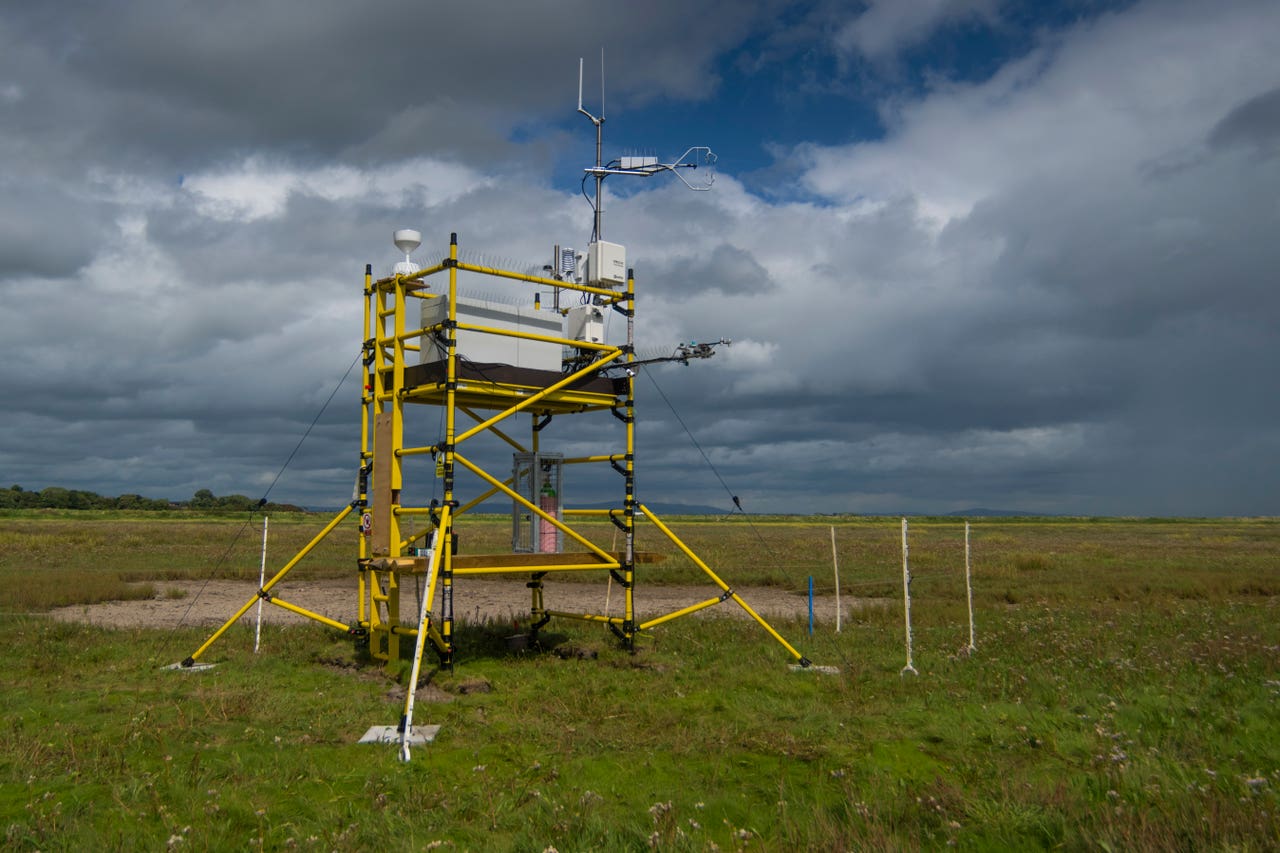
A report from conservation charity WWF in partnership with insurance giant Aviva highlights the important role of saltmarshes around the UK’s coasts in tackling climate change and protecting coastal communities.
The report reveals findings from a solar-powered “carbon flux tower”, funded by Aviva, which measures the exchange of key greenhouse gas carbon dioxide between the air and the saltmarsh on the Ribble Estuary, Lancashire.
It is a technique already used to monitor carbon capture and releases in other vital habitats such as woodlands and peatlands, but has now been adapted and applied to saltmarsh, with the Ribble Estuary producing the first results from a new network of towers.
>> In Other News: Trump Administration Terminates Award for Kentucky Carbon Capture Project

The carbon flux tower used to measure carbon dioxide levels on the Ribble Estuary (Andrew Parkinson/WWF UK/PA)
The data show the habitat is a significant “sink” or store of carbon dioxide, and while there are seasonal fluctuations in storage and release of the gas, the amount absorbed during the spring and summer outweighs what is released during the autumn and winter months.
WWF and Aviva are calling for saltmarshes to be included in the UK’s “greenhouse gas inventory” – the official record of the country’s emissions and removals which is used to track progress towards reducing climate pollution to zero overall, known as net zero.
The two organisations argue that including saltmarshes would improve national reporting and help unlock funding and policy supporting the habitat’s protection and restoration.
Experts warn that 85% of the UK’s saltmarshes, which provide wildlife habitat, carbon capture and natural flood management through slowing the movement of seawater inland, have been lost since the mid 19th century.
The remaining habitat plays a crucial role in shielding coasts from rising seas and storm surges, helping protect assets worth more than £200 billion in England and Wales, the report said.
But with climate change driving rising sea levels, the new report, produced in collaboration with the UK Centre for Ecology and Hydrology and the RSPB, assesses how the country’s remaining marshes are faring as waters rise.
To find out if saltmarshes were able to maintain their height above sea level, the conservationists set up a network of surface elevation tables, which measure how marsh height changes over time, across six UK saltmarshes.
The assessment found that generally saltmarshes were gaining height, although the results varied by region.

Saltmarshes are important habitats for wildlife, as well as carbon stores and protection for coastal communities (Rose Summers/WWF-UK/PA)
Marshes in areas such as Chichester and The Wash in East Anglia appear to be expanding, while those in North Norfolk and the Ribble are showing signs of struggling in the face of rising sea levels, the report said.
Tom Brook, ocean conservation specialist at WWF, said: "The results are in, and mud matters. Saltmarshes are powerful natural allies in the fight against climate change – storing carbon, protecting our coasts and supporting rich biodiversity.
"As extreme weather and rising sea levels put more people and places at risk, the case for protecting and restoring these habitats has never been stronger.
"This research adds to a growing body of evidence showing that saltmarshes are not just ecologically important but essential to building a resilient, net zero future."
Subscribe to the newsletter
Daily decarbonization data and news delivered to your inbox
Follow the money flow of climate, technology, and energy investments to uncover new opportunities and jobs.
Latest issues
-
64 Carbon Projects Were Stuck. Texas Just Unlocked Them
Inside This Issue 🛢️ 64 Carbon Projects Were Stuck. Texas Just Unlocked Them ⚙️ In Ohio, Hydrogen Industry Presses on Despite Federal Uncertainty 🧲 Agami Zero Breaks Through With Magnetic Hydrogen...
-
This U.S. Plant Might Change Aviation Forever
In This Issue 🛫 A Georgia Plant Just Cracked Aviation's Fuel Puzzle 📉 CO2RE And ERM Release 2025 Update On Greenhouse Gas Removal Costs 🔗 Abatable Partners With BlueLayer To Streamline Corporate C...
-
Canada Just Made CCUS Way More Profitable
Inside This Issue 💼 Canada Unlocks EOR for Federal Tax Credits in Landmark Policy Shift 🚀 Carbontech Funding Opens as CDR Sector Pushes for Net-Zero Standard Revisions 💧 CHARBONE Confirms its Firs...
Company Announcements
-
Step strengthens Louisiana’s role in U.S. energy leadership and advances project finance process for biomass‑to‑fuel facility SACRAMENTO, Calif. & NEW ORLEANS -- DevvStream Corp. (Nasdaq: DEVS...
-
Climeworks Opens the World’s Largest Direct Air Capture Innovation Hub
Key takeaways: Climeworks launches the largest innovation center for Direct Air Capture, employing over 50 engineers in Zurich, Switzerland. The center is designed to reduce the cost and increase...
-
XCF Global Moves to Double SAF Production with New Rise Reno Expansion
Initial development completed at New Rise Reno 2, advancing XCF's second SAF production facility and positioning construction to begin in 2026. $300 million planned investment will double XCF'...
-
Carbon Capture Technology Relies on High-Performance CO2 Sensors
As the Global South's first Direct Air Capture (DAC) company, Octavia Carbon has commissioned the world's second DAC + geological storage plant. Harnessing Kenya's abundant renewable geothermal ene...